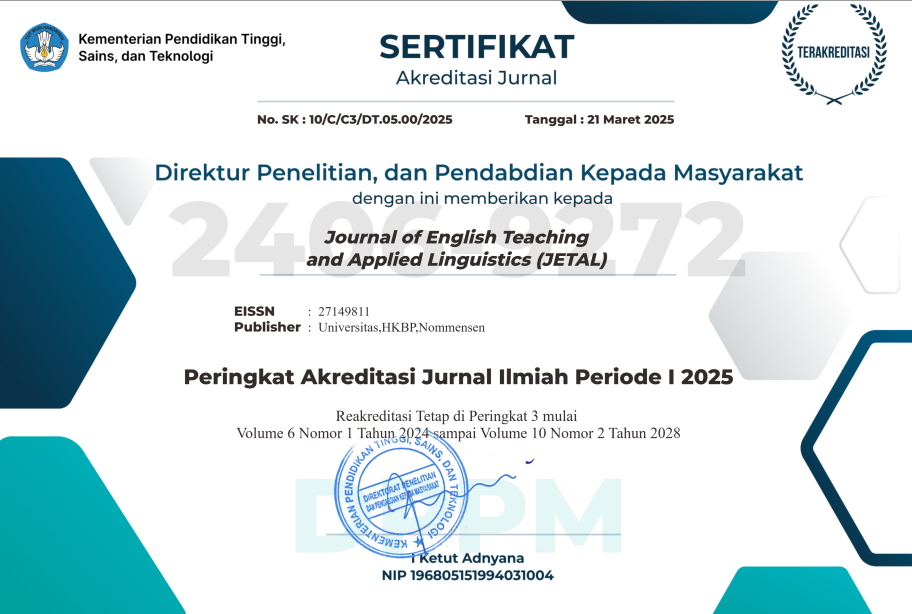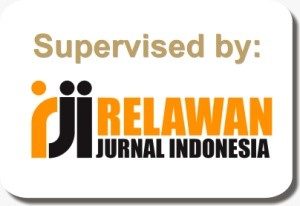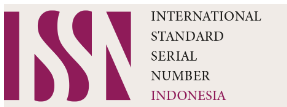USING SHADOWING TECHNIQUE TO IMPROVE STUDENTS’ ABILITY IN LISTENING COMPREHENSION
Abstract
This study was aimed to observe the use of Shadowing technique to improve students’ ability in listening comprehension. This research was conducted by using classroom action research which is consist of two cycles. The sample of the research was one group out of four groups of the first semester students’ of English Department of Nommensen KHBP university which was selected by using random sampling technique. Listening test, observation sheets and diary notes were employed to collect the data. Quantitatively, it showed that there were an improvement of listening ability from the students since the first up to the last treatments. The result showed that in the first treatment there is no students who got the point up to 75. But it increased to 37.5% in the end of the second treatment and 94.28% in the end of the last treatment. Qualitatively, the result showed that the students felt better, easier, and interesting to learn listening that leading to the acquirement of more successful listening comprehension skill. Therefore, shadowing technique could be used to improve students’ ability in listening comprehension.
Keywords: Listening comprehension, shadowing technique
References
Bingol, M.A., et al. 2014. Listening Comprehension Difficulties Encountered by Students in Second Language Learning Class. Journal of Educational and Instruction Studies in the World.
Chao, J.Y. 2013. Factors Affecting College EFL Learners’ Listening Comprehension and Listening Problem. NCUE Journal of Humanities.
Cherry, E.C. 1953. Some Experiments on the Recognition of the Speech, with one and with two ears. The Journal of the Acoustical Society of America.
Chofifah, L and Kumalarini, T. 2013. The Implementation of Jigsaw Listening to Increase the Students’ Listening Comprehension of the Tenth Grade Students of SMAN 1 Porong. eJournal Unesa.
Gilakjani, A.P., and Ahmadi, M.R. 2011. A Study of Factors Affecting EFL Learners’ English Listening Comprehension and the Strategies for Improvement. Journal of Language Teaching and Research.
Hamada, Y. (2012). An Effective Way to Improve Listening Skills through Shadowing. The Language Teacher: Japan Association Language Teaching (JALT).
Hamouda, A. (2013). An Investigation of Listening Comprehension Problems Encountered by Saudi Students in the EFL Listening Classroom. International Journal of Academic Research in Progressive Education and Development.
Lambert, S. (1992). Shadowing. Meta, 37(2).
Richard, J.C., & Lochart, G. 1994. Methodology in Language Teaching: An Anthology of Current Practice. New York, NY: Cambridge University Press
Richards, J.C. 2008. Teaching Listening and Speaking; from Theory to Practice. New York, NY: Cambridge University Press.
Rost, M. 2011. Teaching and Researching Listening. Harlow, England: Pearson Education Limited.
Saputra, J.B. 2014. The Comparison of Listening Comprehension Using Podcast with Audio-visual at Different Listening Habit. The international Journal of Humanities and Social Studies.
Tamai, K. 1997. Shadowing no Koka to Chokai Process Niokeru Ichizuke [The Effectiveness of Shadowing and Listening Process]. Current English Study. Tokyo
Authors retain copyright and grant the journal right of first publication with the work simultaneously licensed under a Creative Commons Attribution-ShareAlike 4.0 International License (CC BY-SA 4.0) that allows others to share the work with an acknowledgment of the work's authorship and initial publication in this journal.
Authors are able to enter into separate, additional contractual arrangements for the non-exclusive distribution of the journal's published version of the work (e.g., post it to an institutional repository or publish it in a book), with an acknowledgment of its initial publication in this journal.
Authors are permitted and encouraged to post their work online (e.g., in institutional repositories or on their website) prior to and during the submission process, as it can lead to productive exchanges, as well as earlier and greater citation of published work (See The Effect of Open Access).






